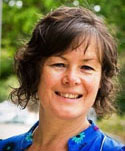Katya Johanson is Senior Lecturer in the School of Communication and Creative Arts at Deakin University. Her research lies in cultural policy and audience development. With Dr Hilary Glow she has researched how cultural policy can increase the sustainability of professional performing arts companies, including Indigenous companies and the small to medium sector. Her work on audience development includes work commissioned by Arts Victoria to examine the capacity of audiences to receive a performing arts experience. Katya is one of three editors of a forthcoming title The Audience Experience (Intellect, 2012).

Hilary Glow is Director of the Arts and Entertainment Management Program at Deakin University. Her research sits within the discipline of arts management and the study of cultural policy and addresses the management and policy settings that frame the operations of cultural organisations; and the role of policy and public funding in supporting cultural organisations and their audiences. With Dr Katya Johanson she has conducted research with Arts Victoria and six performing arts companies on audience engagement, and this collaboration, over a number of years, has led to a series of publications in national and international journals. Also with Dr Johanson, Hilary is the author of Your Genre is Black: Indigenous performing arts and policy (2009).
 Anne Kershaw lectures in arts marketing and project management with the Arts & Entertainment Management Program at Deakin University. Her expertise is in audience development and promoting social inclusion in the arts. Her PhD study involves research into museums’ collaboration with culturally diverse communities. Originally trained as a museum curator, Anne worked in arts and cultural planning in local and state government for 15 years before returning to academia.
Anne Kershaw lectures in arts marketing and project management with the Arts & Entertainment Management Program at Deakin University. Her expertise is in audience development and promoting social inclusion in the arts. Her PhD study involves research into museums’ collaboration with culturally diverse communities. Originally trained as a museum curator, Anne worked in arts and cultural planning in local and state government for 15 years before returning to academia.
Arts Participation: what does it mean in the Australian local government arts and cultural context?
The close proximity between local government and its constituency means that the principles which at a Federal and state level might be abstract and generic, at a local level must inform realistic and tangible strategies in policy-making. Australian local governments are increasingly adopting evidence-based policy approaches to inform and evaluate their arts and cultural development programs. In local government arts and cultural frameworks certain principles such as access and diversity are ubiquitous and well established. Increasingly important is the notion of arts participation, which is regarded as central to government values of wellbeing and citizenship; but how is this principle commonly understood? To what extent is participation evident as a goal of arts and cultural frameworks? What indicators are used to measure the success of the framework in achieving the goal of arts participation? What are the limitations of such indicators?
Research suggests that people are engaging in the arts in increasingly active ways (Brown & Novak-Leonard 2011). Scholars have described the flourishing of active arts participation on a spectrum of activity from spectatorship to co-creation (Leadbeater 2009, Holden 2010, Brown & Novak-Leonard 2011). Based on a review of the current literature on arts participation and interviews with staff from 2-3 Victorian councils, this paper identifies the place of arts participation in the arts and cultural frameworks of local government, critically analyses the ways in which the councils’ record in achieving higher levels of participation is evaluated, and addresses the understanding of this principle and its influence.
